Embark on an extraordinary cosmic journey through the depths of the magnificent Whirlpool Galaxy, a mesmerizing spiral galaxy located approximately 23 million light-years away from Earth. Prepare to be captivated by the astonishing features, mysterious secrets, and hidden wonders that await you in this otherworldly realm of dazzling celestial beauty. From its spiral arms that stretch elegantly across vast cosmic distances to its enigmatic companion galaxy engaged in a cosmic dance, the Whirlpool Galaxy offers a breathtaking spectacle that ignites the imagination and fuels our quest for knowledge. Join us as we delve into the mind-boggling mysteries, compare it with our very own Milky Way, and explore the exciting future of Whirlpool Galaxy exploration.
Contents
- Overview of the Whirlpool Galaxy
- Exploring the Whirlpool Galaxy
- Unanswered Mysteries of the Whirlpool Galaxy
- Our Very Own Milky Way Compared to the Whirlpool Galaxy
- Unveiling the Future of Whirlpool Galaxy Exploration
- Conclusion
-
Frequently Asked Questions
- What is the size of the Whirlpool Galaxy?
- How far away is the Whirlpool Galaxy?
- What gives the Whirlpool Galaxy its distinctive spiral shape?
- What is the companion galaxy of the Whirlpool Galaxy?
- How was the black hole in the Whirlpool Galaxy discovered?
- Are there any known exoplanets in the Whirlpool Galaxy?
- What is the significance of studying star formation in the Whirlpool Galaxy?
- How does the Whirlpool Galaxy compare to our Milky Way?
- What future advancements in technology will aid Whirlpool Galaxy exploration?
- Are there any international space missions focusing on Whirlpool Galaxy research?
- References
-
Frequently Asked Questions
- 1. What is the Whirlpool Galaxy?
- 2. How big is the Whirlpool Galaxy?
- 3. What makes the Whirlpool Galaxy unique?
- 4. How were the spiral arms of the Whirlpool Galaxy formed?
- 5. What is the significance of the Whirlpool’s companion galaxy?
- 6. What has the Hubble Space Telescope revealed about the Whirlpool Galaxy?
- 7. Does the Whirlpool Galaxy have a supermassive black hole?
- 8. How do scientists study star formation in the Whirlpool Galaxy?
- 9. What are some unresolved mysteries about the Whirlpool Galaxy?
- 10. How can future exploration of the Whirlpool Galaxy be enhanced?
- References
- Read More
Overview of the Whirlpool Galaxy
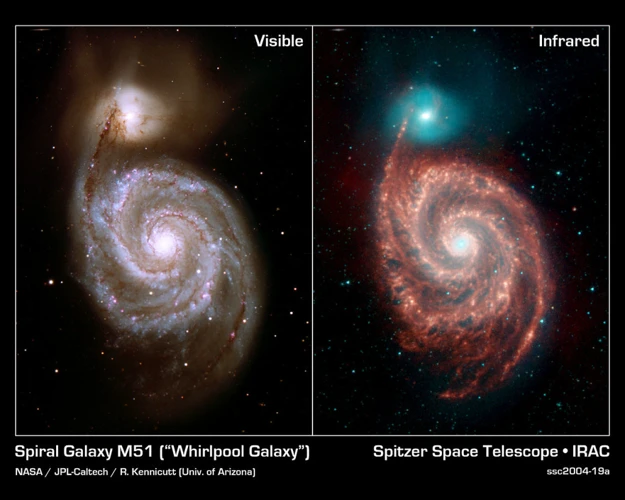
The Whirlpool Galaxy, also known as Messier 51 or M51, is a visually striking spiral galaxy that has captivated astronomers and stargazers alike. Located in the constellation Canes Venatici, this celestial wonder is situated approximately 23 million light-years away from Earth. At the heart of the Whirlpool Galaxy lies a supermassive black hole, an astronomical phenomenon that continues to perplex scientists with its immense gravitational pull. One of the most astounding features of this galaxy is its prominent and well-defined spiral arms, which stretch across vast cosmic distances, showcasing the intricate structure and unparalleled beauty of this cosmic masterpiece. In a stunning display of cosmic ballet, the Whirlpool Galaxy is engaged in a grand duet with its companion galaxy NGC 5195, a smaller galaxy that is in the process of being gravitationally distorted by its larger counterpart. This cosmic dance adds to the allure and mystique of the Whirlpool Galaxy, making it a subject of great fascination and scientific study. Its immense size and awe-inspiring beauty make it an excellent subject for telescopic observation and study. Through the lens of the Hubble Space Telescope, astronomers have been able to capture breathtaking images that reveal the intricate details and celestial wonders within this awe-inspiring galaxy. With its rich history, enigmatic black hole, and enthralling spiral arms, the Whirlpool Galaxy continues to ignite our curiosity and push the boundaries of our understanding of the vast cosmos.
Astounding Features of the Whirlpool Galaxy
The Whirlpool Galaxy boasts a plethora of astounding features that make it a standout among the celestial wonders of the universe. One of its most remarkable characteristics is its prominent and well-defined spiral arms. These arms, composed of a dazzling array of stars, gas, and dust, gracefully swirl outward from the galaxy’s center in a mesmerizing symphony of cosmic beauty. The spiral pattern of the arms is a result of density waves, which create regions of compression and expansion, causing the material within the galaxy to cluster and form these majestic structures. Another awe-inspiring feature of the Whirlpool Galaxy is its extensive system of star-forming regions. These regions, known as HII regions, are areas where hydrogen gas is being ionized by the intense ultraviolet radiation emitted by young, hot stars. This process leads to the formation of new stars, which then illuminate the surrounding nebulae with a dazzling array of colors. The Whirlpool Galaxy is also home to a supermassive black hole at its center, which exerts a tremendous gravitational pull on the surrounding material. This black hole is estimated to have a mass millions of times greater than that of our sun, and its presence significantly influences the dynamics of the galaxy. These astounding features of the Whirlpool Galaxy contribute to its allure and make it a subject of fascination for astronomers and stargazers alike.
The Whirlpool Galaxy’s Spiral Arms
At the core of the Whirlpool Galaxy’s mesmerizing beauty lies its stunning spiral arms – a defining feature that sets it apart and makes it a celestial spectacle to behold. These spiral arms, intricately structured and gracefully curved, spiral outward from the galactic center, creating a visually captivating display of cosmic artistry. The Whirlpool Galaxy’s spiral arms are composed of stars, gas, and dust, intertwining in a delicate cosmic dance that spans incredible distances. The arched pathways of these arms guide the movement of celestial bodies within the galaxy, shaping the dynamics of star formation and the evolution of the galactic structure. These majestic spiral arms serve as a testament to the immense gravitational forces at play, gently pulling and shaping the materials within the galaxy. As astronomers peer into the depths of these arms, they discover regions of intense star formation, where newborn stars emerge from vast clouds of gas and dust. Studying the Whirlpool Galaxy’s spiral arms offers valuable insights into the processes that drive galactic evolution, star formation, and the intricate interplay of celestial forces. Through advanced telescopes and spectroscopic observations, scientists continue to unravel the secrets and unravel the mysteries veiled within the enigmatic spiral arms of this cosmic wonder. To explore how exoplanets are detected and the techniques used in this fascinating field of astronomy, click here.
The Perfect Cosmic Dance: Whirlpool’s Companion Galaxy
The Whirlpool Galaxy’s companion, NGC 5195, adds a mesmerizing element to this cosmic spectacle, as the two galaxies engage in a perfect cosmic dance. Nestled close to the larger Whirlpool Galaxy, NGC 5195 is a smaller galaxy that is currently being gravitationally distorted by its larger neighbor. This interaction between the two galaxies creates a breathtaking display of celestial beauty. The gravitational forces at play cause NGC 5195’s shape to be elongated and distorted, with its outer arms stretching towards the Whirlpool Galaxy. This phenomenon, known as tidal interactions, not only alters the shape of NGC 5195 but also triggers intense bursts of star formation within the galaxy. The gravitational interaction between these galaxies plays a crucial role in the evolution of both objects. The study of this cosmic dance provides astronomers with valuable insights into the dynamics of galactic interactions and the influence they have on star formation. Through detailed observations and analysis, scientists are able to unravel the mysteries of these cosmic encounters and gain a better understanding of the complex processes that shape our vast universe. The perfect cosmic dance between the Whirlpool Galaxy and its companion NGC 5195 showcases the profound interconnectedness of celestial objects and ignites our imagination about the wonders that lie beyond our own galaxy’s boundaries.
Exploring the Whirlpool Galaxy
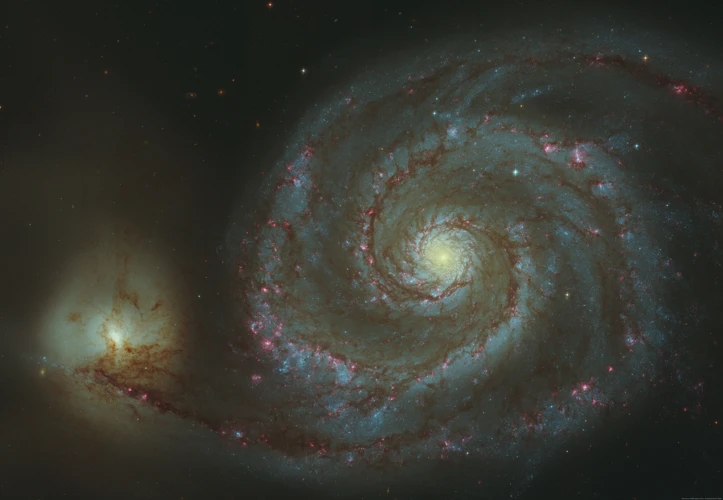
Exploring the Whirlpool Galaxy is an endeavor fueled by curiosity and scientific inquiry as we seek to unravel its mysteries and gain deeper insights into the workings of the universe. Through the lens of the Hubble Space Telescope, astronomers have captured captivating images that showcase the grandeur and intricacy of this cosmic marvel. These images allow us to witness the vibrant colors, swirling dust lanes, and clusters of young stars within the Whirlpool’s spiral arms, painting a vivid picture of celestial beauty. One of the areas of particular interest is the Whirlpool’s supermassive black hole, located at its core. Scientists are using advanced techniques and instruments to study the behavior and properties of this cosmic monster, aiming to understand its impact on the galaxy’s evolution. Additionally, observing star formation in the Whirlpool Galaxy provides valuable insights into the processes that shape galaxies as a whole. By analyzing the birth and life cycles of stars within this galactic giant, astronomers can expand our understanding of the universe’s composition and development. The Whirlpool Galaxy serves as a fascinating laboratory for astronomical research, enabling scientists to explore the intricacies of cosmic phenomena and expand our knowledge of the cosmos. With each exploration, we uncover new insights and push the boundaries of our understanding further, propelling us on a never-ending journey of cosmic discovery.
The Hubble Space Telescope’s Captivating Images
The Hubble Space Telescope has played a pivotal role in bringing the captivating beauty of the Whirlpool Galaxy to our screens. Through its advanced optics and cutting-edge technology, Hubble has captured stunning and detailed images of this cosmic marvel. These images provide us with a front-row seat to the intricate structures and celestial phenomena present within the Whirlpool Galaxy. The spiral arms, adorned with brilliant clusters of young stars and glowing clouds of gas and dust, are depicted with remarkable clarity and vibrancy. The Hubble images showcase the dynamic nature of the galaxy, revealing the ongoing process of star formation and the interaction between different stellar populations. The telescope’s high-resolution capabilities unravel the intricate details of the galaxy’s core, where the supermassive black hole resides, surrounded by a swirling disk of hot gas and dust particles. These captivating images enable astronomers to study the Whirlpool Galaxy in unprecedented detail, uncovering valuable insights into galaxy formation, stellar evolution, and the dynamics of black holes. The Hubble Space Telescope continues to be an invaluable tool for expanding our understanding of the Whirlpool Galaxy and the wonders of the universe at large.
Unraveling the Secrets of the Whirlpool’s Black Hole
Unraveling the Secrets of the Whirlpool’s Black Hole:
The supermassive black hole at the center of the Whirlpool Galaxy is a cosmic enigma that continues to astound astronomers and researchers. Stretching its gravitational reach across vast distances, this black hole holds many secrets waiting to be unraveled. Scientists have long been fascinated by the intense gravitational pull of black holes, where the laws of physics as we know them seem to break down. Through the use of innovative technologies and advanced telescopes, astronomers have been able to study the effects of the black hole on its surrounding environment. They have observed the swirling motion of matter as it spirals towards the event horizon, the point of no return. The black hole’s immense gravitational force causes the surrounding gases and dust to heat up and emit powerful radiation that can be detected across various wavelengths, including X-rays and gamma-rays. By analyzing these emissions, scientists can gain insights into the properties and behavior of the black hole. One of the key mysteries surrounding the Whirlpool’s black hole is its origin and formation. Scientists are still trying to determine whether it formed through the collision and merger of smaller black holes or through the collapse of a single massive star. By studying the gravitational waves emitted during these cataclysmic events, scientists hope to unravel the origins of this cosmic giant. Understanding the inner workings of black holes not only contributes to our knowledge of the universe but also provides valuable insights into the processes that shape galaxies and shape the cosmic landscape. The study of black holes goes beyond Whirlpool’s black hole alone, as it has implications for a wide range of astronomical phenomena, from the formation of galaxies to the detection of exoplanets in distant star systems. As our technology and understanding continue to evolve, so too will our ability to decode the secrets held within these mysterious cosmic entities. (Source: [exoplanet detection methods](/exoplanet-detection-methods/))
Studying Star Formation in the Whirlpool Galaxy
Within the vast expanse of the Whirlpool Galaxy, a process of cosmic creativity unfolds as stars are born in spectacular fashion. Studying star formation in this celestial wonderland provides a window into the mechanisms that shape and define galaxies. Astronomers have observed dense regions of gas and dust within the Whirlpool Galaxy, known as molecular clouds, which serve as the nurseries for new stars. These molecular clouds are composed predominantly of hydrogen and helium, the building blocks of stars. As these clouds collapse under their own gravity, they begin to fragment into smaller clumps, giving birth to protostars. These protostars are in the early stages of stellar evolution, where gravitational forces cause them to become hotter and denser over time. As the protostars continue to grow and gather mass, they eventually ignite into a glorious fusion-powered blaze, becoming fully-fledged stars. This ongoing cycle of star formation is a vital process in shaping the galaxy, influencing its structure and contributing to its overall cosmic tapestry. Scientists use various observational methods and tools, such as spectroscopy and infrared imaging, to study this fascinating phenomenon. By examining the regions within the Whirlpool Galaxy where star formation is most active, astronomers can gain insights into the factors that trigger and regulate this process. Understanding the intricacies of star formation not only sheds light on the evolution of galaxies like the Whirlpool but also deepens our comprehension of the cosmic processes that have shaped and continue to shape our universe.
Unanswered Mysteries of the Whirlpool Galaxy
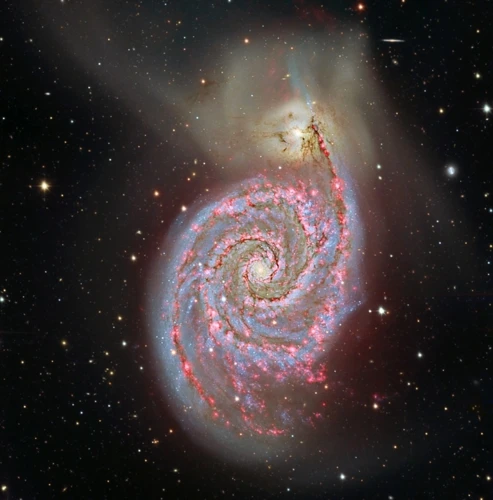
The Whirlpool Galaxy, with all its splendor and grandeur, still holds numerous unanswered mysteries that continue to intrigue and bewilder scientists. One enigma lies within the heart of the galaxy, where a supermassive black hole resides. This colossal black hole exerts a tremendous gravitational force, but the exact mechanisms of how it formed and accumulated its massive size remain unclear. Scientists are also puzzled by the phenomenon of star formation within the Whirlpool Galaxy. The galaxy’s spiral arms are filled with cosmic nurseries where new stars are born, but the precise triggers and processes that initiate and regulate this star formation activity are yet to be fully understood. Another mystery lies in the nature of the Whirlpool Galaxy’s interactions and mergers with other galaxies throughout its existence. These interactions play a crucial role in shaping the galaxy’s structure and dynamics, but the exact history and consequences of such encounters remain shrouded in uncertainty. Despite these unanswered questions, researchers continue to study the Whirlpool Galaxy using advanced telescopes and observing techniques, in the hopes of unraveling its secrets and gaining deeper insights into the workings of the universe.
Our Very Own Milky Way Compared to the Whirlpool Galaxy
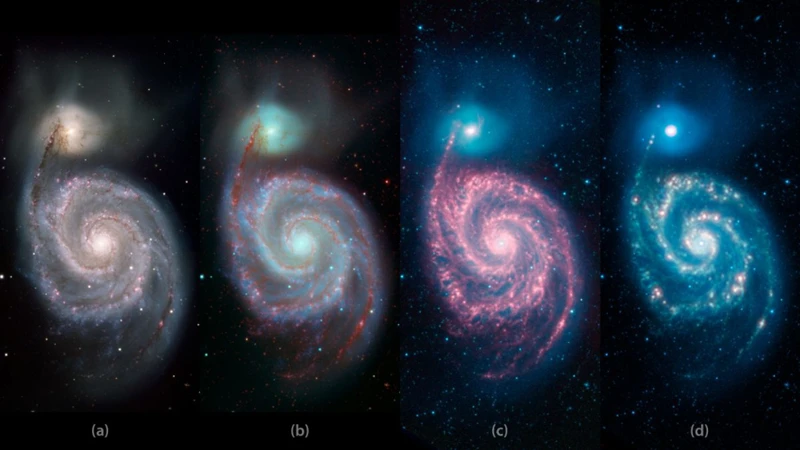
When it comes to comparing our very own Milky Way to the Whirlpool Galaxy, there are both striking similarities and intriguing differences to consider. Both galaxies belong to the same family of spiral galaxies and exhibit beautiful spiral arms that extend from their central bulges. However, there are notable distinctions in terms of size and structure. The Whirlpool Galaxy is larger than the Milky Way, with a diameter of approximately 60,000 light-years, compared to the Milky Way’s 100,000 light-year diameter. Additionally, the Whirlpool Galaxy boasts a more pronounced and tightly wound spiral structure, while the Milky Way has a more loosely wound spiral pattern. Another fascinating contrast is the presence of a companion galaxy in the Whirlpool Galaxy, NGC 5195, which interacts dynamically with its larger neighbor. In contrast, the Milky Way does not have a companion galaxy as prominent as NGC 5195. Despite these disparities, both galaxies share a common heritage and offer glimpses into the remarkable diversity of the cosmic landscape. Exploring the similarities and divergences between the Whirlpool Galaxy and our own Milky Way leads to a deeper appreciation of the vastness and complexity of the universe we inhabit.
Unveiling the Future of Whirlpool Galaxy Exploration
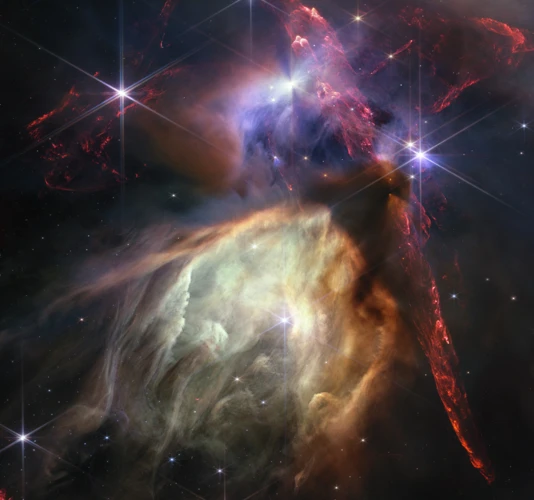
The future of Whirlpool Galaxy exploration holds great promise, as advancements in technology and the advent of new generation telescopes offer exciting possibilities for unraveling its mysteries. One such breakthrough comes from the development of more powerful telescopes, like the James Webb Space Telescope (JWST), set to launch in the near future. This revolutionary instrument will enable astronomers to peer even deeper into the Whirlpool Galaxy, capturing images with unprecedented clarity and detail. The JWST’s advanced capabilities will allow scientists to study star formation, delve further into the nature of the supermassive black hole at the galaxy’s center, and potentially uncover new insights into the formation and evolution of spiral galaxies. Another important aspect of future Whirlpool Galaxy exploration lies in the role of interstellar travel. As technology advances, the possibility of manned missions to galaxies beyond our own becomes more conceivable. The Whirlpool Galaxy, with its striking visual appeal and intriguing cosmic features, is a prime candidate for future exploration and study. Collaborative efforts between international space agencies may pave the way for ambitious missions to this distant celestial wonder and open up new avenues of scientific inquiry. Unleashing the full potential of these collaborative ventures would allow us to gain a deeper understanding of the Whirlpool Galaxy and shed light on universal questions about the nature and origins of the cosmos. The future of Whirlpool Galaxy exploration holds immense promise, merging cutting-edge technology, interstellar travel, and collaborative efforts to unlock the secrets of this cosmic gem.
New Generation Telescopes and Advancements in Technology
The exploration of the Whirlpool Galaxy has been greatly enhanced by the advancements in technology and the development of new generation telescopes. These cutting-edge instruments provide astronomers with unprecedented capabilities to observe and study celestial objects with remarkable precision and detail. One such example is the James Webb Space Telescope (JWST), which is set to launch in the near future. With its larger aperture and advanced imaging capabilities, the JWST will revolutionize our understanding of the Whirlpool Galaxy and other distant galaxies. Another remarkable advancement is the Square Kilometre Array (SKA), a radio telescope project that will have a collecting area of one square kilometer, making it the most sensitive radio observatory ever built. The SKA will enable astronomers to delve even deeper into the mysteries of the Whirlpool Galaxy and explore its radio emissions with unprecedented clarity. Advancements in data analysis and computational algorithms have empowered scientists to process and interpret the vast amount of data collected from these telescopes more efficiently. The combination of these technological advancements allows researchers to unravel the secrets of the Whirlpool Galaxy and gain valuable insights into its formation, evolution, and interactions with its companion galaxy. As technology continues to evolve, new avenues of observation and exploration will open up, propelling our understanding of the Whirlpool Galaxy and the broader universe to unprecedented heights. Through these advancements, the doors to the cosmos are being flung wide open, enabling us to peer deeper into the cosmic abyss and make remarkable discoveries that were once unimaginable.
The Role of Interstellar Travel in Whirlpool Galaxy Research
Interstellar travel plays a significant role in the research and exploration of the Whirlpool Galaxy. As scientists strive to unravel the mysteries hidden within its vast expanse, the ability to travel through interstellar space becomes crucial. The immense distance between our planet and the Whirlpool Galaxy, combined with the limitations of current space exploration technology, makes it incredibly challenging to physically reach this cosmic wonder. However, advancements in theoretical concepts such as warp drives, wormholes, and other speculative methods of faster-than-light travel offer glimpses of hope for future interstellar missions. The potential breakthroughs in interstellar travel could revolutionize Whirlpool Galaxy research, allowing us to send sophisticated spacecraft equipped with advanced instruments and telescopes to explore this mesmerizing galaxy up close. By studying the Whirlpool Galaxy from within its borders, scientists would gain unprecedented access to invaluable data, enabling them to uncover hidden truths about its formation, structure, and enigmatic features. While interstellar travel remains a distant dream, ongoing scientific research and technological advancements bring us closer to the possibility of one day embarking on an extraordinary journey to the Whirlpool Galaxy, opening up new frontiers in our quest to understand the marvels of the universe.
Collaborative Efforts and International Space Missions
Collaborative efforts and international space missions play a vital role in advancing our understanding of the Whirlpool Galaxy and unraveling its many mysteries. Astronomical research and exploration are often collaborative endeavors, with scientists and experts from different nations and organizations pooling their resources, expertise, and data to achieve remarkable discoveries. International space missions, such as the NASA/ESA Hubble Space Telescope, have been instrumental in capturing high-resolution images and collecting valuable data about the Whirlpool Galaxy. These missions involve the collaboration of scientists, engineers, and technicians from various countries, working together to ensure the success of the mission. The sharing of knowledge, resources, and technology enables scientists to address complex questions and challenges associated with studying the Whirlpool Galaxy. With each new mission and collaborative endeavor, new insights are gained, contributing to our expanding knowledge of this celestial wonder. These collaborative efforts also foster a sense of unity and cooperation among nations, as scientists from different backgrounds come together to explore and understand the vastness of the universe. As technology advances and new generation telescopes are developed, international collaborations will continue to be at the forefront of Whirlpool Galaxy research, allowing us to delve deeper into its mysteries and push the boundaries of our understanding of the cosmos beyond.
Conclusion

In conclusion, the Whirlpool Galaxy stands as a testament to the magnificence and complexity of the universe we inhabit. Its breathtaking spiral arms, captivating dance with its companion galaxy, and enigmatic black hole have intrigued astronomers and stargazers for centuries. Through the advancements of technology and the tireless efforts of researchers, we have been able to unravel some of the secrets hidden within this cosmic wonder. The stunning images captured by the Hubble Space Telescope have allowed us to witness the sheer beauty and grandeur of this celestial spectacle. As we compare the Whirlpool Galaxy to our own Milky Way, we gain a deeper appreciation for the vastness and diversity of the cosmos. Looking towards the future, we can only imagine the exciting advancements that lie ahead in Whirlpool Galaxy exploration. With the development of new generation telescopes and advancements in technology, we have the potential to unlock even more mysteries and gain further insights into the workings of this awe-inspiring galaxy. Collaborative efforts and international space missions will undoubtedly play a crucial role in expanding our knowledge and pushing the boundaries of understanding. As we continue to explore and study the Whirlpool Galaxy, we open doors to new discoveries and reshape our perception of the universe. The journey through the Whirlpool Galaxy is one that inspires wonder, fuels our curiosity, and reminds us of the limitless wonders that exist beyond our own celestial neighborhood.
Frequently Asked Questions

What is the size of the Whirlpool Galaxy?
The Whirlpool Galaxy is considered a medium-sized galaxy with a diameter of approximately 60,000 to 100,000 light-years.
How far away is the Whirlpool Galaxy?
The Whirlpool Galaxy is located approximately 23 million light-years away from Earth.
What gives the Whirlpool Galaxy its distinctive spiral shape?
The Whirlpool Galaxy’s spiral shape is a result of its rotating disk of stars and gas. The gravitational forces within the galaxy cause the gas and dust to condense into spiral arms.
What is the companion galaxy of the Whirlpool Galaxy?
The companion galaxy of the Whirlpool Galaxy is NGC 5195, a smaller galaxy that appears to interact gravitationally with the Whirlpool Galaxy.
How was the black hole in the Whirlpool Galaxy discovered?
The black hole at the center of the Whirlpool Galaxy was discovered through observations of the motion of stars and gas in that region. The high velocities and gravitational effects indicated the presence of a massive black hole.
Are there any known exoplanets in the Whirlpool Galaxy?
As of now, there have been no confirmed detections of exoplanets within the Whirlpool Galaxy. Current exoplanet detection methods primarily focus on our own Milky Way galaxy.
What is the significance of studying star formation in the Whirlpool Galaxy?
Studying star formation in the Whirlpool Galaxy provides valuable insights into the processes and conditions that give rise to new stars. It helps astronomers better understand the life cycle of galaxies and how they evolve over time.
How does the Whirlpool Galaxy compare to our Milky Way?
The Whirlpool Galaxy and our Milky Way have some similarities, such as their spiral structure. However, the Whirlpool Galaxy is larger and more massive than our Milky Way. Additionally, the Whirlpool Galaxy has a more active rate of star formation.
What future advancements in technology will aid Whirlpool Galaxy exploration?
New generation telescopes and advancements in technology, such as improved imaging techniques and spectroscopy, will play a crucial role in further exploring and understanding the Whirlpool Galaxy.
Are there any international space missions focusing on Whirlpool Galaxy research?
Currently, there are no specific international space missions solely dedicated to Whirlpool Galaxy research. However, various collaborative efforts among different space agencies and institutions continue to contribute to our knowledge of this fascinating cosmic object.
References
Frequently Asked Questions

1. What is the Whirlpool Galaxy?
The Whirlpool Galaxy, also known as Messier 51 or M51, is a stunning spiral galaxy located approximately 23 million light-years away from Earth. It is named after its distinctive spiral structure, which resembles a swirling vortex or whirlpool.
2. How big is the Whirlpool Galaxy?
The Whirlpool Galaxy spans a diameter of about 60,000 light-years, making it relatively similar in size to our own Milky Way galaxy. It contains an estimated 100 billion stars, along with a vast amount of interstellar gas and dust.
3. What makes the Whirlpool Galaxy unique?
One of the standout features of the Whirlpool Galaxy is its gravitational interaction with a smaller companion galaxy, which has sparked intense scientific interest. This interaction has triggered waves of star formation and created a bridge of gas and dust between the two galaxies.
4. How were the spiral arms of the Whirlpool Galaxy formed?
The spiral arms of the Whirlpool Galaxy are believed to have formed through a combination of gravitational forces and density waves. These waves compress interstellar gas and dust, promoting the formation of new stars and giving rise to the characteristic spiral structure.
5. What is the significance of the Whirlpool’s companion galaxy?
The companion galaxy of the Whirlpool, known as NGC 5195 or M51b, plays a crucial role in our understanding of galactic evolution. Its interaction with the Whirlpool Galaxy triggers star formation and provides insights into the processes that shape and transform galaxies over time.
6. What has the Hubble Space Telescope revealed about the Whirlpool Galaxy?
The Hubble Space Telescope has captured stunning images of the Whirlpool Galaxy, revealing intricate details of its spiral arms, star clusters, and dust lanes. These images have allowed scientists to study the galaxy’s structure, dynamics, and the formation of new stars.
7. Does the Whirlpool Galaxy have a supermassive black hole?
Yes, the Whirlpool Galaxy is believed to harbor a supermassive black hole at its center. Studying this black hole and its interaction with the surrounding environment provides insights into the role of black holes in galaxy formation and evolution.
8. How do scientists study star formation in the Whirlpool Galaxy?
Scientists study star formation in the Whirlpool Galaxy by observing regions of intense star formation called starburst regions. They analyze the distribution of young stars, the properties of interstellar gas clouds, and the feedback mechanisms that regulate the birth and death of stars.
9. What are some unresolved mysteries about the Whirlpool Galaxy?
Despite extensive research, there are still mysteries surrounding the Whirlpool Galaxy. Scientists are particularly interested in understanding the precise mechanisms that drive the formation and structure of its spiral arms, as well as the interplay between its supermassive black hole and the surrounding stars and gas.
10. How can future exploration of the Whirlpool Galaxy be enhanced?
The future exploration of the Whirlpool Galaxy can be enhanced through the development of next-generation space telescopes and advancements in technology. Additionally, collaboration between international space agencies and efforts to develop interstellar travel capabilities would allow for more in-depth study and understanding of this remarkable galaxy.







